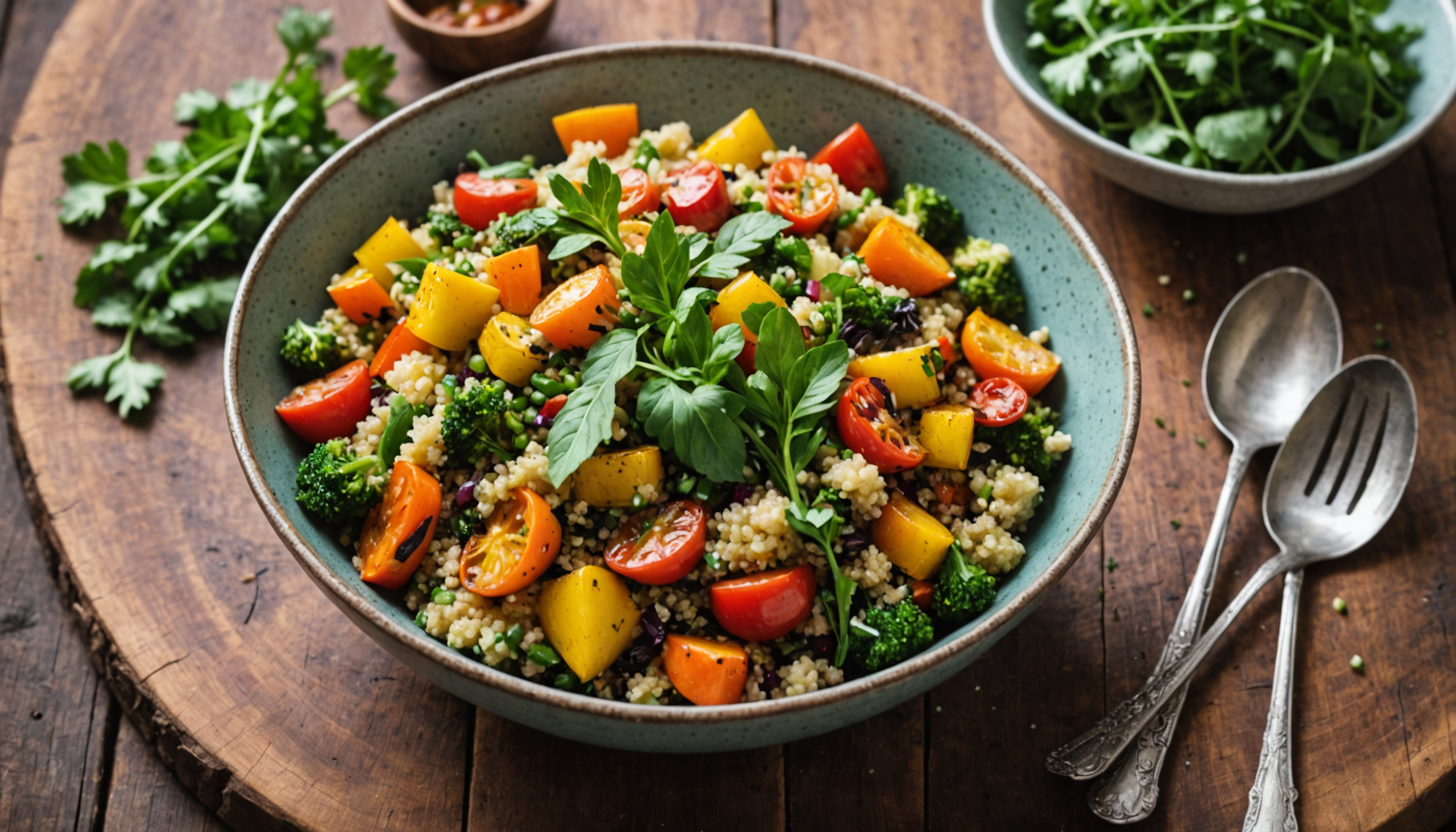- Plant-Based Dinner Recipe Essentials
- Nutritional Benefits of a Plant-Based Diet
- Easy-to-Make Organic Dinner Recipes
- Seasonal Ingredients for Flavorful Meals
- Tips for Meal Prepping and Planning
- Creative Ways to Serve Plant-Based Dishes
Grocery shopping can be a rewarding journey when you know what to look for, especially for those eager to embrace a plant-based lifestyle. Whether you’re hunting for local, organic produce or searching for budget-friendly vegan options, here are some practical tips to enhance your shopping experience.
Start by making a list based on your intended meals for the week. This not only helps you avoid impulse buys but also ensures you gather all the essential ingredients for your vegan recipes. Focus on whole foods—fruits, vegetables, whole grains, nuts, and legumes are the backbone of any plant-based pantry.
- Prioritize Seasonal Produce: Not only does this support local agriculture, but seasonal ingredients often taste better and are typically more affordable. Visit a local farmers’ market for the freshest picks.
- Explore Bulk Bins: Nuts, grains, and seeds are often cheaper when purchased in bulk. Consider items like quinoa, lentils, chia seeds, and rolled oats.
- Choose Organic When Possible: Organic produce is grown without harmful pesticides and fertilizers. For items like tomatoes, strawberries, and leafy greens, organic is especially important.
When looking for vegan foods, read labels carefully. Ingredients can often be misleading. Look out for added sugars, preservatives, and artificial ingredients that may sneak into seemingly healthy products.
For those pressed for time but eager to eat healthy, online grocery shopping can be a lifesaver. Many stores offer delivery options or curbside pickup. However, be vigilant about safety when shopping online:
- Check Reviews: Before strolling through virtual aisles, read store reviews regarding their product quality and delivery service.
- Inspect Packaging: Make sure that the items are well packaged and not expired. If receiving perishable items, choose a delivery time when you can promptly transfer them to refrigeration.
Furthermore, look out for sales and discount codes when shopping online. Many retailers have regular promotions on organic and vegan products, which can help you stay within budget while nourishing your family with nutritious meals.
To keep your expenses in check, consider joining a community-supported agriculture (CSA) program. This not only provides you with a regular supply of fresh, local produce but often at a discounted price compared to retail.
Lastly, making an effort to learn about local farms and food co-ops can dramatically change your grocery game. By establishing direct relationships with food producers, you can often find high-quality organic offerings at competitive prices.
Nutritional Benefits of a Plant-Based Diet
A plant-based diet offers a myriad of nutritional benefits that contribute to overall health and wellness. At its core, this dietary lifestyle emphasizes the consumption of whole, minimally processed foods, which are packed with essential nutrients necessary for optimal functioning. Here are several key advantages of adopting a plant-based diet:
1. Rich in Nutrients: A plant-based diet is abundant in vitamins, minerals, and antioxidants. Fruits, vegetables, whole grains, nuts, and legumes provide essential nutrients like vitamin C, potassium, magnesium, and dietary fiber, which are crucial for maintaining bodily functions and preventing nutrient deficiencies.
2. Weight Management: Numerous studies indicate that individuals following a plant-based diet tend to have lower body weights and body mass indexes (BMIs) compared to those consuming more animal products. This can be attributed to higher fiber intake from plant foods, which contributes to increased satiety and reduced overall calorie consumption.
3. Heart Health: A diet low in saturated fats and cholesterol, commonly found in animal products, can significantly decrease the risk of heart disease. Plant-based foods, particularly fruits and vegetables, contain compounds that can help lower blood pressure and improve cholesterol levels. A wide variety of foods, such as avocados, berries, and leafy greens, play a role in improving heart health by reducing inflammation and oxidative stress.
4. Reduced Risk of Chronic Diseases: Research shows that a well-planned plant-based diet can help reduce the risk of chronic diseases such as type 2 diabetes, certain cancers, and obesity. The anti-inflammatory properties of plant foods, coupled with their fiber content, support metabolic health and contribute to disease prevention.
5. Digestive Health: The high fiber content in a plant-based diet promotes digestive health by enhancing gut flora diversity, regulating bowel movements, and preventing constipation. Fiber-rich foods such as legumes, whole grains, fruits, and vegetables are essential for maintaining a healthy digestive system.
6. Sustainability and Environmental Impact: While not a direct nutritional benefit, embracing a plant-based diet contributes to environmental sustainability. Animal agriculture is a significant contributor to greenhouse gas emissions, deforestation, and water usage. A plant-based approach helps mitigate these effects, aligning personal health with planetary well-being.
To illustrate the nutritional impact of a plant-based diet, consider the following comparison of key nutrients in plant-based foods versus typical animal products.
| Nutrient | Plant-Based Sources | Animal Sources |
|---|---|---|
| Protein | Quinoa, lentils, chickpeas | Chicken, beef, eggs |
| Iron | Spinach, beans, tofu | Red meat, poultry |
| Calcium | Kale, broccoli, fortified plant milks | Dairy products |
| Omega-3 Fatty Acids | Chia seeds, walnuts, flaxseeds | Fatty fish |
| Fiber | Whole grains, fruits, vegetables | Limited |
Incorporating a variety of these plant-based foods into daily meals provides the body with necessary nutrients while maximizing health benefits. This nutritional foundation supports an active lifestyle and enhances the quality of life, making it an ideal choice for those looking to nourish their bodies through wholesome, delicious meals.
Easy-to-Make Organic Dinner Recipes

When it comes to stocking your kitchen for easy-to-make organic dinners, grocery shopping can indeed feel daunting, but a little planning goes a long way. Start with your essentials: ensure you stock up on ingredients that can form the foundation of your vegan recipes. These might include versatile staples like quinoa, brown rice, canned beans, and lentils, which can serve as the base for a variety of meals.
Don’t underestimate the power of fresh herbs and spices! They can elevate even the most basic dishes into flavorful masterpieces. Items such as basil, cilantro, garlic, and ginger not only add zest but also offer various health benefits. Invest in some organic herbs to enhance the taste of your plant-based meals while keeping things nutritious.
- Leafy Greens: Always have a supply of greens like kale, spinach, or arugula on hand. These can be added to salads, smoothies, and stir-fries for a nutrition boost.
- Colorful Vegetables: Stock up on a rainbow of vegetables—bell peppers, sweet potatoes, carrots, and zucchini. Not only do they provide essential vitamins and minerals, but they also create visual appeal on your dinner plate.
- Whole Grains: Opt for whole grains over refined ones. Options such as farro, barley, and whole grain pasta bring fiber and nutrients to your meals.
While shopping, be mindful of the produce you are choosing. Look for organic options when available, especially for items on the Environmental Working Group’s Dirty Dozen list, which include strawberries, spinach, and apples. Organic foods, although sometimes pricier, can be worth the investment for their reduced pesticide exposure.
If you’re aiming for budget-friendly options, consider shopping at discount grocers, local farms, or co-ops. Buying in bulk can also help save costs, especially for items like nuts, seeds, and whole grains. Many stores offer discounts on bulk purchases which allows you to add diverse ingredients to your pantry without breaking the bank.
Be cautious with food safety. Particularly when purchasing organic products, check for quality indicators such as vivid colors and firm textures. Examine packaging for damages or expiration dates when you’re shopping online. Ensure that the online retailer you choose has a good reputation and clear return policies in case you receive unsatisfactory or spoiled goods.
- Stay Informed: It’s wise to familiarize yourself with the best times to shop for seasonal produce. For instance, tomatoes are abundant and less costly in summer, while root vegetables shine in fall and winter.
- Plan Your Meals: Meal prepping can reduce waste and help you stay organized. If you cook meals in bulk, consider freezing individual portions for future meals.
Lastly, remember that grocery shopping should be enjoyable. Consider trying out new ingredients or experimenting with different cuisines to keep your meals exciting. Whether you’re preparing a comforting chili with lentils or a vibrant stir-fry packed with colorful vegetables, the adventure begins with your shopping list!
Seasonal Ingredients for Flavorful Meals
Seasonal ingredients can transform ordinary dishes into extraordinary meals, infusing them with vibrant flavors and nutrients. Utilizing ingredients at their peak freshness not only enhances the taste of your plant-based dishes but also supports sustainable farming and local economies. The beauty of seasonal cooking lies in its variety; each season presents a plethora of fruits and vegetables that can inspire your culinary creativity.
As you navigate through the seasons, berries and stone fruits emerge during the warmer months. Juicy strawberries, peaches, and cherries provide a natural sweetness that can elevate desserts, smoothies, and salads alike. These fruits are perfect for creating refreshing summer salads topped with a zesty vinaigrette or blended into a creamy smoothie bowl for breakfast. Incorporating seasonal produce into your meals means enjoying the maximum flavor while supporting local farmers.
Autumn brings an abundance of root vegetables and squashes, such as sweet potatoes, carrots, and butternut squash. These hearty ingredients are not only comforting but are also rich in vitamins and minerals. Roasting them with a sprinkle of olive oil, salt, and herbs brings out their natural sweetness, making for a satisfying side dish or main course. Imagine a warm, spiced quinoa and roasted vegetable bowl, finished off with a tahini drizzle—a perfect dish to warm your soul as the weather cools.
When winter sets in, hearty greens like kale and cabbage come into play, providing robust nutrients to counter the winter chill. They shine in soups, stews, and stir-fries. A warming kale and white bean soup, simmered with garlic and thyme, offers both flavor and comfort, making it an ideal choice as the temperatures drop. Utilizing sprouted grains such as farro or barley can add unique textures and flavors to your dishes, enriching your meals even further.
As spring arrives, an array of fresh greens returns to the market, including spinach, asparagus, and peas. These vibrant ingredients are perfect for light, refreshing meals. A simple pasta dish tossed with spring vegetables, olive oil, and lemon zest showcases the season’s bounty beautifully. The lighter profile of spring foods allows for experimentation with herbs like dill and mint, which can create refreshing and aromatic dishes.
Emphasizing seasonal ingredients in your meals also encourages variety in your diet, ensuring you consume a wide range of nutrients throughout the year. Making use of what’s in season provides an opportunity to explore new flavors and textures, creating excitement in your kitchen.
“The time to eat is when the food is at its best.” – Unknown
Moreover, seasonal cooking can also engage all the senses, from the vibrant colors that fill your plate to the aromas that fill your kitchen. Engaging with local farmers or visiting farmers’ markets can deepen your understanding of how seasons influence food availability, helping you create recipes that reflect what is local and fresh.
Incorporating seasonal ingredients into your evening meals doesn’t just enhance flavor; it fosters a connection with the cycles of nature. Embrace the bounty that each season offers and allow that to guide your plant-based meals, celebrating the earth’s gifts through every bite.
Tips for Meal Prepping and Planning
 Planning and prepping your meals not only makes eating healthy more manageable, but it also saves time and stress during the week. By dedicating time to meal prep, you can create a balanced menu that utilizes your favorite plant-based ingredients, ensuring that nutritious and delicious organic dinners are always within reach. Start by selecting a few recipes that excite you, and then gather all the necessary ingredients.
Planning and prepping your meals not only makes eating healthy more manageable, but it also saves time and stress during the week. By dedicating time to meal prep, you can create a balanced menu that utilizes your favorite plant-based ingredients, ensuring that nutritious and delicious organic dinners are always within reach. Start by selecting a few recipes that excite you, and then gather all the necessary ingredients.
One essential tip for effective meal prepping is batch cooking. Prepare larger quantities of staples such as grains and legumes at the beginning of the week. For example, cook a big pot of brown rice or quinoa that can be used as a base for various dishes, from grain bowls to stir-fries. Similarly, preparing legumes like chickpeas or lentils in advance can allow you to create quick salads or soups when you’re short on time.
Don’t forget the importance of storing your prepped ingredients properly. Invest in quality, airtight containers to keep cooked foods fresh in the fridge or freezer. Labeling containers helps with organization and ensures that you use items before they spoil. Creating individual portion sizes can also encourage healthy eating habits, making it easier to grab a quick, nourishing meal during busy days.
Incorporating seasonal ingredients into your meal prep can add both flavor and nutrition to your dishes. When you choose fruits and vegetables that are currently in season, you enhance the taste profile of your meals, allowing fresh produce to shine. Consider prepping a seasonal vegetable medley that can be easily roasted or steamed to accompany different main dishes throughout the week.
Another key factor in successful meal planning is variety. Rotate recipes to prevent boredom, and try new plant-based ideas that may include cuisines from various cultures. Experimenting with flavors and ingredients not only keeps your palate excited but also ensures a more balanced intake of different nutrients.
Lastly, utilize time-saving tools like slow cookers or pressure cookers. These gadgets can significantly decrease cooking time and simplify meal preparation, allowing you to create wholesome meals without much hands-on effort. Imagine coming home to a fragrant stew or chili, prepared effortlessly while you went about your day.
- What are the best containers for meal prepping?
- Opt for glass or BPA-free plastic containers that are microwave and dishwasher safe. Choose containers with compartments if you like to keep ingredients separate, ensuring freshness and texture.
- How can I prevent my meal prepped food from spoiling?
- Ensure that food is stored in airtight containers and kept at regulated temperatures. Freeze meals that you won’t consume within a few days, and always label items with dates to track freshness.
- Can meal prepping help with weight management?
- Yes, meal prepping encourages portion control and makes healthy eating more convenient, which can lead to reduced calorie intake and improved dietary choices.
- How do I decide what to meal prep?
- Focus on recipes that emphasize seasonal ingredients and utilize similar ingredients throughout the week. This not only reduces food waste but also allows for a diverse range of meals.
- What are some easy plant-based recipes for meal prep?
- Consider recipes like quinoa salad with roasted vegetables, lentil soup, or vegetable stir-fry. These dishes can be made in large quantities and adjusted to suit your taste.
- How long can I keep prepped meals in the refrigerator?
- Most prepped meals can last in the refrigerator for about 3 to 5 days. If you’re not eating them within that timeframe, freeze them for longer storage.
- Is meal prepping time-consuming?
- While initial meal prepping can take some time, planning ahead often saves you time during busy weekdays. Batch cooking can significantly simplify each meal and reduce cooking time later on.
Creative Ways to Serve Plant-Based Dishes
Getting creative with how you serve your plant-based dishes can transform everyday meals into appealing feasts for the family, fitness aficionados, and even guests who may be new to a vegan lifestyle. Whether you’re preparing a quick weeknight dinner or a festive gathering, presentation and serving ideas can elevate your dishes from simple to spectacular.
Start with the basics: color. Incorporating a variety of colorful ingredients not only boosts nutritional value but also creates an enticing visual experience. Serve vibrant roasted vegetables, such as red bell peppers, purple carrots, and green broccoli, arranged beautifully on a large platter. You can amp up the visual aspect by sprinkling fresh herbs on top, creating stunning contrast against the colorful backdrop of your meal.
- Bowls: Bowl meals continue to be popular for a reason. They are customizable and visually appealing. Begin with a base of grains like quinoa or brown rice, layer on your favorite seasonal vegetables, and top with a protein source such as chickpeas or edamame. Don’t forget a drizzle of sauce, like tahini or a spicy peanut dressing, to tie the flavors together.
- Make It Interactive: Serving meals that allow family members to build their own plates can transform dinner into a fun experience. Set up a taco night with soft corn tortillas, a variety of fillings like black beans, roasted veggies, and avocado, along with toppings such as salsa and cilantro. This not only creates a joyful atmosphere but invites everyone to choose what they love most.
- Plates and Utensils Matter: Consider using well-designed plates and cutlery to enhance the dining experience. Unique bowls for soups or striking plates for salads can make a notable difference. Opting for compostable utensils for outdoor gatherings also adds an eco-friendly touch.
- Garnishes: Never underestimate the power of garnishes! A sprinkle of sesame seeds, a dollop of vegan yogurt, or freshly chopped herbs can take a dish from ordinary to extraordinary. These small additions can boost flavor while also beautifying your plate.
When hosting or serving a larger audience, balance your offerings. Include substantial dishes like hearty stews or casseroles alongside lighter options such as salads or grain bowls. This ensures there’s something for everyone, catering to various preferences and dietary needs without the stress of cooking a dozen different meals.
For dessert, explore plant-based treats that are easy to prepare yet perfect for sharing. Mini plant-based cheesecakes or chocolate mousse made from avocados can provide a rich indulgence that feels restaurant-worthy without much effort. Consider serving them in glass jars for a chic presentation.
Meal Pairing: Think carefully about beverage pairings as well! A refreshing herbal tea or a light, organic wine can complement your plant-based dishes wonderfully, enhancing the dining experience further. When in doubt, ask your local wine shop for recommendations that pair well with vegetarian fare.
Lastly, don’t forget about the impact of ambiance. Simple touches like dim lighting, calming music, and even flowers on the table can enhance the meal. These elements play a critical role in creating a relaxed atmosphere, making your plant-based dinners feel special, whether for a simple family meal or a lively gathering.
New Customers Offer!
Free Gift for the new customer
$24 Value, When You Subscrib Visit Thrive Market












